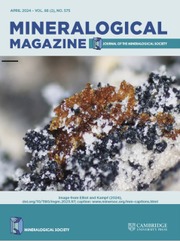No CrossRef data available.
Article contents
Natromolybdite, Na2MoO4·2H2O, a new mineral from fumarole deposits of the Tolbachik volcano, Kamchatka, Russia
Published online by Cambridge University Press: 24 June 2025
Abstract
The new mineral natromolybdite, ideally Na2MoO4·2H2O, was found in the Arsenatnaya fumarole, Second scoria cone of the Northern Breakthrough of the Great Tolbachik Fissure Eruption, Tolbachik volcano, Kamchatka, Russia. The associated minerals are halite, sylvite, aphthitalite, belomarinaite, powellite, hematite, sanidine, tilasite, johillerite, bradaczekite, badalovite, arsmirandite, wrightite, arsenatrotitanite, dmisokolovite, litidionite, rutile and cristobalite. Natromolybdite occurs as rectangular, octagonal or rhomb-like lamellar to thin-tabular crystals up to 40 μm across and up to 3 μm thick, in near-parallel, pile-like or rose-like aggregates and crystal crusts up to 0.2 mm across. It is transparent and colourless, with vitreous lustre. Dcalc is 2.573 g/cm3. The synthetic analogue of natromolybdite is optically biaxial (+), α = 1.575(2), β = 1.576(2), γ = 1.598(3) and 2Vmeas = 20(10)°. The chemical composition (wt.%, electron microprobe, H2O is calculated by stoichiometry) is: Na2O 25.51, K2O 0.66, SO3 1.04, MoO3 58.21, H2Ocalc 15.05, total 100.47. The empirical formula, calculated based on O = 6 apfu, is (Na1.971K0.034)Σ2.005(Mo0.968S0.031)Σ0.999O4·2H2O. Natromolybdite is orthorhombic, space group Pbca, a = 8.483(1), b = 10.577(2), c = 13.842(2) Å, V = 1242.0(2) Å3 and Z = 8. The nine strongest reflections of the powder XRD pattern [d,Å(I)(hkl)] are: 6.92(100)(002), 4.243(20)(200), 4.206(32)(022), 3.618(31)(202), 3.310(31)(220), 3.169(49)(131), 3.067(21)(114), 2.987(30)(222) and 2.681(15)(204, 311). Natromolybdite (IMA-accepted symbol Nmyb) is named for the chemical composition. It is a natural analogue of a well-studied synthetic sodium molybdate dihydrate.
Information
- Type
- Article
- Information
- Copyright
- © The Author(s), 2025. Published by Cambridge University Press on behalf of The Mineralogical Society of the United Kingdom and Ireland.
Footnotes
Associate Editor: Daniel Atencio

